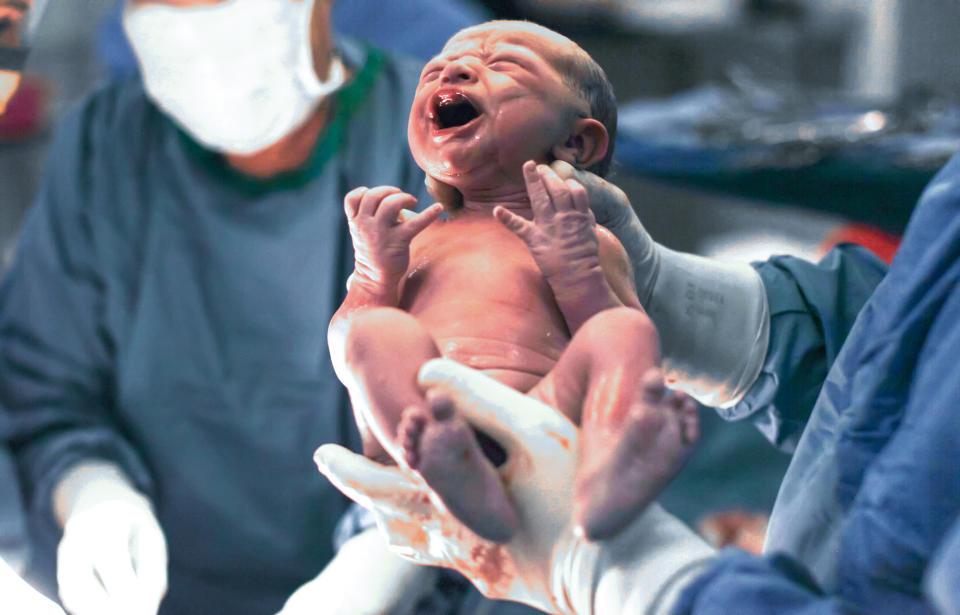Why C-section rates have doubled around the world
Infant delivery through incisions made in the mother’s abdomen and uterus — known as a cesarean section (or C-section) — has long been a point of debate in the health world.
Now, with new research showing that the rate of C-sections has nearly doubled, it’s primed to ruffle even more feathers.
The study, published in The Lancet, found that C-section rates went from 16 million (12.1 percent of all births) in 2000 to 29.7 million (21.1 percent of all births) across the globe in 2015.
Women in some countries were more likely to have C-sections than those in others, and in at least 15 countries more than 40 percent of all babies were delivered by C-section. The Dominican Republic had the highest rate — 58.1 percent of new moms there delivered via C-section, the study found.

What the research says
The study comes on the heels of new guidance released by the World Health Organization (WHO) Thursday as part of a growing effort to curb unnecessary C-sections.
“A caesarean section is a surgical procedure that, when undertaken for medical reasons, can save the life of a woman and her baby,” the guidance states.
“Many caesarean sections are undertaken unnecessarily however, which can put the lives and well-being of women and their babies at risk — both in the short and the long-term.”
The WHO’s recommendations include educational interviews, the use of clinical guidelines to determine when a C-section is necessary, a requirement for second opinion for a C-section, and interventions aimed at health organizations, like having midwives collaborate with ob-gyns.
What the medical experts say
“Cesarean rates are epidemic, and we’ve got to stop doing this,” Michael Cackovic, MD, a maternal-fetal medicine specialist at the Ohio State University Wexner Medical Center, tells Yahoo Lifestyle.
The most common reason why women have a cesarean in the U.S. is that they gave birth via C-section before, he says. “What we’re really trying not to do is that first cut,” Cackovic says.
While C-sections are unnecessary in some situations, it’s important to note that there are valid medical reasons for having one performed.

Reasons to have a C-section
“Common reasons to have a C-section include a mom’s choice to decline a trial of labor after a history of a prior cesarean, breech presentation, fetal heart rate abnormalities during labor, and lack of progression of labor either due to lack of further dilation or movement of the baby’s head despite mom’s effort to push for several hours,” Lisa Valle, DO, an ob-gyn at Providence Saint John’s Health Center in Santa Monica, Calif., tells Yahoo Lifestyle.
Problems with the placenta, carrying a very large baby, a maternal infection like herpes, maternal high blood pressure, and carrying multiples that aren’t in a good position for a vaginal delivery can also be viable reasons, according to the American College of Obstetricians and Gynecologists.
Why doctors don’t encourage C-sections
Women can elect to have a C-section, but it’s not really encouraged, Valle says.
“Her ob-gyn or midwife should have an extensive discussion regarding the risks of a C-section versus the risks of labor and vaginal delivery so that she can make a fully informed decision,” she says.
“Her physician or midwife should also inquire about her reasoning for an elective C-section and address her concerns directly.”
For the record, doctors usually want to try to have a patient do vaginal birth if they can.
“We will always try to avoid a cesarean section, and we would only recommend one if we felt it was in the best interest of both the mother and baby,” Gerardo Bustillo, MD, an ob-gyn at MemorialCare Orange Coast Medical Center in Fountain Valley, Calif., tells Yahoo Lifestyle.
“If a cesarean is needed, it is important to know that it is a common operation which is not experimental, and although surgical risks exist, the medical team is equipped to provide the procedure safely and without pain to the mother.”
“If you have a doctor that you really trust, listening to your doctor is important,” Cackovic says.
Lower the risk of needing a C-section
Women can lower their risk of needing a C-section “by getting good prenatal care, avoiding excessive weight gain during pregnancy, and actively engaging with her obstetrician and support staff during pregnancy,” Bustillo says.
If you’re told you need to have a C-section, you shouldn’t panic.
“It is the most common surgery that’s done in obstetrics, and it is done very well,” Jessica Shepherd, MD, a minimally invasive gynecologist and founder of an online women’s health forum called Her Viewpoint, tells Yahoo Lifestyle.
“Women who may be displeased with the news that they have to have a cesarean have to look at that fact that it’s a frequently performed surgery and, at the end of the day, we’re ultimately looking for a safe and healthy baby and mom,” she says.
“If there’s something hindering that outcome, a C-section may be the way to go.”
However, if your doctor tells you that you’ll need a C-section in advance of your birth and you’re not completely confident in that decision, “It’s OK to get a second opinion,” Shepherd says.

 Yahoo Lifestyle
Yahoo Lifestyle 

